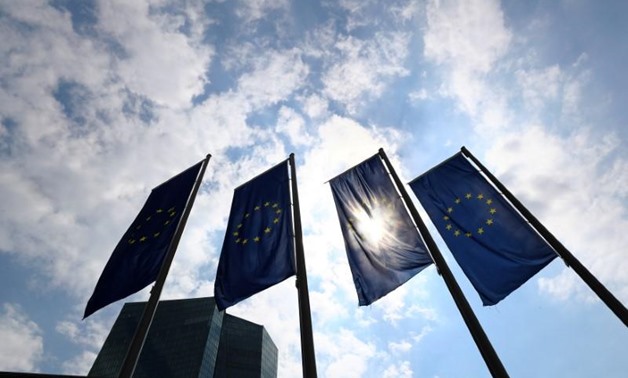
Flags in front of the European Central Bank (ECB) before a news conference at the ECB headquarters in Frankfurt, Germany, April 27, 2017. REUTERS/Kai Pfaffenbach
LONDON - 7 September 2017: European Central Bank policymakers hold a widely anticipated meeting later on Thursday, amid speculation the central bank wants to wind down its extraordinary bond-buying monetary stimulus soon.
However, this year’s surge in the euro exchange rate complicates the ECB’s exit strategy. It curtails already sub-target inflation by making dollar-priced imports cheaper, dragging down the booming export sector and cutting into corporate earnings from outside the bloc.
Any mention of the euro and its relative impact on financial and economic conditions, as a result, may be the biggest market mover on Thursday.
Here’s what financial markets are looking for from the ECB’s statement and President Mario Draghi’s press conference.
1. EURO STRENGTH
The euro’s more than 13 percent rise against the dollar so far this year, its biggest in 14 years, puts the currency at the top of investor watch lists.
Absolute levels for the euro are still below its levels since ECB chief Mario Draghi promised to save the euro zone, but it is the speed of the move that is a concern.
On a trade-weighted basis, the euro EUR=ECBF has gained nearly 6 percent in less than five months. That strength creates obstacles for both economic growth and inflation in the euro zone.
Sources told Reuters last week that euro strength could delay ECB plans to roll back stimulus, and Draghi is sure to be asked about the currency in the post-meeting news conference.
(For a graphic on 'Euro Valuations' click reut.rs/2gLznAT)
2. POLICY STATEMENT
With currency strength making a rare appearance in the minutes of the last policy meeting on July 20, markets will watch if the currency gets more attention in the formal post-meeting statement this week.
Despite the reference, Morgan Stanley analysts say mention of the currency has dropped sharply in recent months after data-mining each policy statement and accompanying press conference since 1998.
July’s policy statement had an abnormally low nine mentions of the currency compared with an average of 27 in the last two years and far below 56 times at its March meeting.
“I think they will be careful not to push any major changes - they are wary of the exchange rate,” said Robert Skelton, a portfolio manager at Mediolanum Asset Management.
3. STAFF FORECASTS
Revisions to the ECB’s staff projections following recent gains in the euro is another important focus.
Markets expect a slight downward revision in core inflation forecasts, although analysts said the ECB’s long-term forecasts may be little changed and should not in themselves derail plans for tapering next year.
Inflation in the 19-country currency bloc, which the ECB aims to keep just below 2 percent, accelerated to 1.5 percent in August from 1.3 percent.
The ECB forecasts inflation of 1.5 percent in 2017 and 1.3 percent in 2018.
4. TAPERING
Markets have pushed back expectations for when the ECB will signal a scaling back of its stimulus, to October from September. The latest Reuters poll predicts the same.
Still, ECB comments will be scrutinized for any clues on the timing and scale of a taper.
About 36 percent of government bond yields in the euro zone are below zero, compared with a peak in June 2016 of 51 percent, according to JP Morgan Asset Management. Globally, 30 percent of government bond yields are sub zero.
Frederik Ducrozet, an economist at Pictet Wealth Management, expects the ECB to lay the groundwork for the decision to be made by year-end, tasking its committees to study all policy options for 2018.
(For a graphic on 'Money markets scale back rate-hike bets' click reut.rs/2vKPvcL)
5. BOND-BUYING PARAMETERS
The ECB may also be questioned about a growing scarcity of eligible bonds for the bond-buying scheme, which might encourage it to wind down stimulus sooner rather than later.
The ECB bought fewer German bonds in August than in any month since the start of the stimulus programme, suggesting it was holding back to avoid running out of debt to buy.
As the ECB pushes against its self-imposed limits for asset purchases, bond investors will be looking for any changes in the composition of the bond-buying scheme -- whether that’s in country allocation or changes in the mix of corporate and government bonds in the scheme.
“The general sense is that it is all going down,” said Nandini Ramakrishnan, global market strategist at JP Morgan Asset Management.
“The 60 billion euros a month includes both (corporate and government bonds), so reducing that, we think, could proportionately reduce the purchases in both.”
6. MARKET IMPLICATIONS
The market reaction itself could be in the spotlight, especially if the euro moves sharply either way.
European stocks peaked at a two-year high in May, and the pan-European STOXX 600 equity index has fallen by around 6 percent since then, with euro zone stocks .STOXXE shedding a similar amount. Some investors blamed the euro’s blistering ascent as the main culprit.
European banking stocks .SX7P will benefit from any hawkish slant, as a low-rate environment has hurt margins. Banks have so far underperformed the broader market and are relatively cheap.
If the ECB maintains the status quo, European stocks may rise, as companies in the pan-European equity index get more than half their revenues outside the euro zone, according to estimates from Societe Generale.


Comments
Leave a Comment